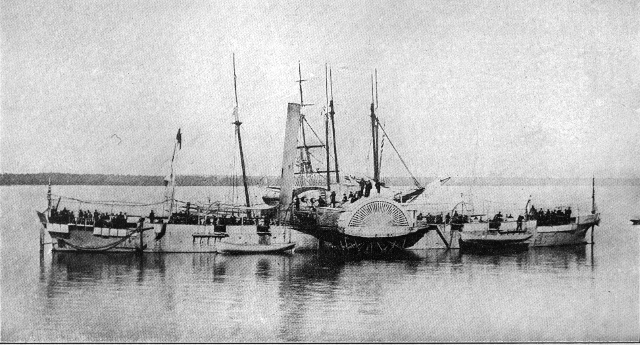last update Saturday, 17-Jul-2021 07:20:53 PDT
Welcome...
McLean Research Associates is dedicated to presenting little known facts about the US Navy in the Civil War, presentations on a myriad of astronomical topics,STEM workshops, and letterboxing.
In commemoration of the 160 years since the Civil War - or more appropriately in the vernacular of the day - The War of the Slaveholders' Rebellion - we are featuring a quote and picture of the day from the Naval Records
 USS Miami played a pivotal role in the Sounds of North Carolina |
|
Wed Apr 05 1865 James B Harvey, US Minister, Lisbon, writes CMDR Thomas T Craven, USS Niagra "The flag of the United States is to be hoisted over the Tower of Belem to-morrow (Thursday) at noon precisely, and to be saluted with twenty-one guns in token of reparation for an indignity offered to the U. S. S. Niagara, under your command, by the ex-governor of that fortification exceeding his instructions. COL F D Sewall, USA, Annapolis, telegrams LCOL J H Taylor, USA, Chief of Staff,"Steamer Harriet De Ford was captured at Fair Haven, in Chesapeake Bay, 30 miles below here, at 2 o'clock this morning, by a rebel party of 27, headed by Captain Fitzhugh. She is a one masted propeller, upper works painted drab. The captain, mate, and white passengers were released; the crew taken. She immediately sailed after a propeller towing two Government barges down the bay. Have nothing here to send in pursuit. Have telegraphed to commanding officer at Fortress Monroe, Point Lookout, and Baltimore." CMDR T A Dornin, telegrams SECNAV "I am just informed that two vessels have been captured by the rebels, the Harriet De Ford last night in Herring Bay, and the St. Mary's on the 1st of April, at the mouth of the Patuxent River. I have no small steamer to dispatch to look after them. Could you not dispatch two light draft steamers, either from Potomac Flotilla or Hampton Roads, to put a stop to this business ?" SECNAV telegrams CDR Foxhall A Parker, Potomac Flotilla, "The steamer Harriet De Ford was captured at Fair Haven, in Chesapeake Bay, 30 miles below Annapolis, at 2 o'clock this morning, by a rebel party. She is a one-masted propeller, upper works drab. She immediately went in pursuit of another steamer in sight. Use your best exertions to recapture the steamer or overtake the rebel party." Parker replies "Dispatch received. I am off and have sent ten more vessels in pursuit of the Harriet De Ford." CDR Parker writes LCDR Edward Hooker, 1st Division, Potomac Flotilla, "The transport Harriet De Ford has been captured in Chesapeake Bay by a party of rebels. You will therefore be particularly careful in overhauling all steamers and be prepared to sink the De Ford should you fall in with her. CDR Parker writes LCDR T H Eastman, USS Don, "The transport Harriet De Ford has been captured in Chesapeake Bay by a party of rebels. You will therefore be particularly careful in overhauling all steamers and be prepared to sink the De Ford should you fall in with her. SECNAV telegrams RADM David D Porter, North Atlantic Blockading Squadron,"Send immediately a picket launch or Greek alphabet steamer to join the Potomac Flotilla." RADM David D Porter, North Atlantic Blockading Squadron, writes SECNAV "As the movements here have been of a military character, and have been regularly reported to the War Department, I have not deemed it necersary to report anything to the Department. RADM Jonathan Dahlgren, South Atlantic Blockading Squadron, writers a general order "By order of his Excellency President Lincoln, the flag of the Union that was hauled down at Fort Sumter on the 14th of April, 1861, is to be restored to its place by Major-General Anderson on the next anniversary of that event. MGEN E R S Canby, USA, Army of West Mississippi writes RADM J K Thatcher, West Gulf Blockading Squadron, "I propose, as soon as our occupation of the north end of Minette Bay is secured, to organize a force for the purpose of capturing Battery Tracy or Huger, or both of them. In this we shall need the assistance of the navy, if it can be spared, in boats and in sailors to man them. I wish to send about 200 volunteers from the army, and we shall need eight or ten boats in addition to those we have, and fifty or sixty sailors to row them. Will you please advise me at your earliest convenience whether you can give us this assistance ?" SECNAV writes CMDR J B Hull, Philadelphia Navy Yard, "Your letter of the 4th instant has been received. |
Teachers and Educators - we have several Civil War presentations covering the US Navy throughout the Civil War which include our portable museum, Submarines, and key naval and land battles. Check out our Civil War section for more details. We also have several presentations on astronomy for all age groups

This website Copyright 1999-2019 McLean Research Associates
This site
The MRA logo is a trademark of McLean Research Associates. All menu buttons and the background anchor are copyright 1999 by MRA